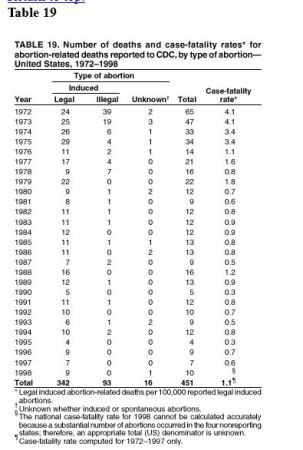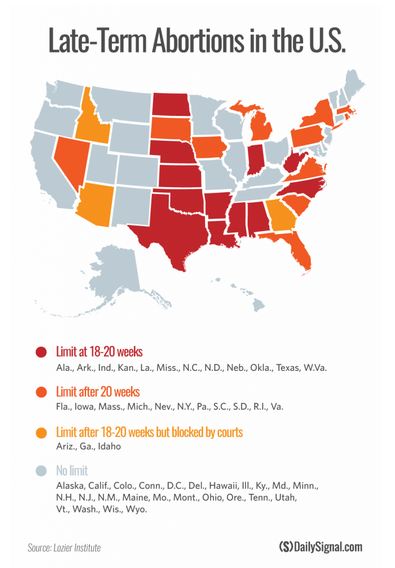As we enter another year of legalized abortion on demand, many Americans may be unaware of certain facts regarding the history of abortion in the United States. Below are seven facts you may not have heard…
1. Abortion was legal prior to 1973 in certain states.
In 1967, Colorado became the first state in the US to legalize abortion. The bill was introduced by then Representative Richard D. Lamm. In 1968, Georgia legalized abortion. Then during the debate to liberalize abortion in New York in 1970, the issue of unsafe abortions swayed one representative to change his vote on the floor, opening the door to abortion on demand in that state.
2. Few women died from abortion the year prior to its legalization.
Despite the repeated lie that thousands (or even millions) of women died from illegal abortion, there was then – as there still is today – no law requiring the reporting of deaths of women from abortion.
 Statistics from the Centers for Disease Control show that the year prior to Roe (1972), 66 women were reportedly killed from abortion.
Statistics from the Centers for Disease Control show that the year prior to Roe (1972), 66 women were reportedly killed from abortion.
Out of those, 39 were illegal, 24 were legal, and two were unknown. However, in the year abortion was legalized (1973), the CDC documents that more women died from legal abortion than from illegal abortions:
3. “Jane Roe” of Roe v. Wade never had – or wanted- an abortion.

Norma McCorvey informs public that she is Roe (Screen grab: ABC News)
The 1973 abortion case was brought to the Supreme Court on the basis that “Jane Roe” had been raped and wanted an abortion. But the truth is that “Roe” – Norma McCorvey – was never raped and never wanted an abortion. In fact, Norma is now pro-life and is seeking to overturn the infamous decision.
4. The language for Roe was written years before the case was decided.
In 1962, the American Law Institute (ALI), comprised of judges, lawyers, and law professors who suggest recommendations for revisions to state laws, proposed liberal abortion language as part of the “model penal code.” As a result, between the years 1962 and 1973, 19 states reformed their abortion laws and enacted all or part of the institute’s reform model. Hawaii, Alaska, New York, and Washington removed all limitations for performing an abortion. Portions of the language read very close to what the Justices eventually enacted – even including the “exceptions” language that opened the door for abortion on demand:
[a] licensed physician is justified in terminating a pregnancy if he believes there is a substantial risk
(1) that continuation of the pregnancy would gravely impair the physical and mental health of the mother or
(2) that the child would be born with grave physical or mental defect, or
(3) that the pregnancy resulted from rape, incest, or other felonious intercourse.

5. Roe v. Wade allowed for unrestricted abortions up to viability (24 weeks) with states deciding thereafter.
According to Paul Pauker, who previously summarized Roe for Live Action, the Supreme Court adopted a trimester framework for state regulation of abortion. The Court held that in the first trimester of pregnancy, states may not regulate abortion; in the second trimester, states may regulate abortion only in ways related to protecting the mother’s health; and in the third trimester, states may “regulate, and even proscribe, abortion except where necessary, in appropriate medical judgment, for the preservation of the life or health of the mother.” (By the way, since Roe, measures of viability have drastically improved.)
6. Doe v. Bolton, Roe’s companion case, opened the door for abortion on demand by allowing the “health of the mother” exception to be defined however the doctor chose.
Pauker states that the language that seemed to allow a third trimester ban on abortion was deceptive, because in Doe, the Court gave “health” such a broad definition that states have been prevented from successfully imposing bans on abortion, including even late-term abortions.

Sandra Cano: the “Doe” of Doe v. Bolton
Testimony from Sandra Cano, the “Doe” of Doe v. Bolton, stated before the Subcommittee on the Constitution of the Senate Judiciary Committee on June 23, 2005 that, like Norma McCorvey, she also never wanted an abortion:
The Doe v. Bolton Supreme Court decision bears my name. I am Sandra Cano, the former “Doe” of Doe v. Bolton. Doe v. Bolton is the companion case to Roe v. Wade. Using my name and life, Doe v. Bolton falsely created the health exception that led to abortion on demand and partial birth abortion. How it got there is still pretty much a mystery to me. I only sought legal assistance to get a divorce from my husband and to get my children from foster care. I was very vulnerable: poor and pregnant with my fourth child, but abortion never crossed my mind. Although it apparently was utmost in the mind of the attorney from whom I sought help.
7. In the majority of states, abortion is legal up until birth.

The U.S. is one of only seven developed countries in which late-term abortions after 20 weeks (five months) are allowed, according to a 2015 report from the Charlotte Lozier Institute. The above graphic published by the Daily Signal reveals just how many states allow abortions through all nine months of pregnancy.
Find more facts you may not know about legal abortion here and here.







